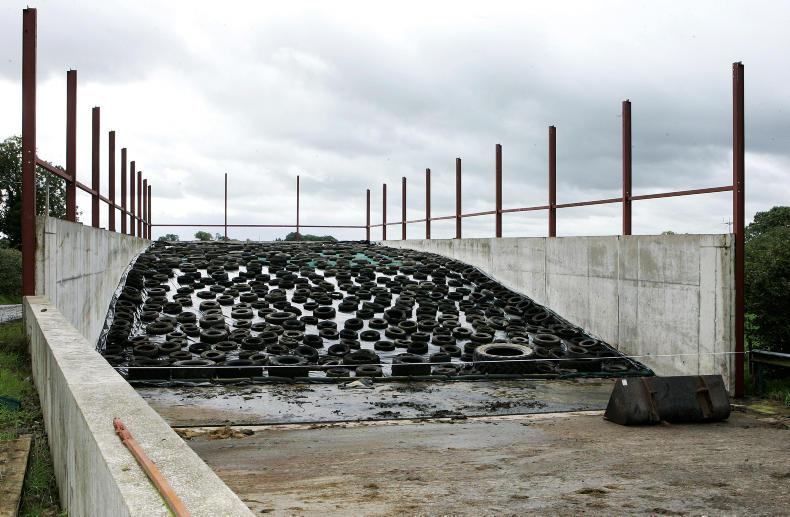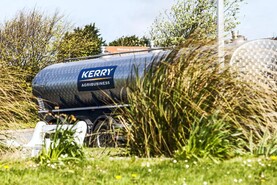First-cut silage on Richard Marshall’s farm was ensiled 10 days later this year when compared with the 2020 campaign.
Similar to previous years, it was carried out in two phases, and the first 40 acres was mowed down on 16 May.
“The first bit was snatch and grab. It was cut one day and then was put in the next morning. It got a light bit of rain, although it wasn’t too bad. Another 80 acres was put in on 24 May in ideal conditions,” Richard said.
“It has been a later year for growth, so we had to wait like everyone else. Although considering that it was cut later, quality still seemed reasonable. It is not rocket fuel by any means, but I am happy enough,” he added.
The Omagh man was busy spreading slurry on silage ground and a week later he topped up fields with fertiliser. Results from last winter’s soil analysis are used as the basis for nutrient applications.
For example, fields which have no phosphorus or potassium deficiency received 22m3/ha (2,000 gallon/acre) of slurry and then 310kg/ha (2.5 bags/acre) of 27% nitrogen.
The cold spring, coupled with periods of wet weather, has meant the 2021 grazing season has been stop-start on the Marshall farm until recently.
The milking herd was out at grass by day and night in April, but had to be housed full-time for a few days in May when the weather broke. The cows stayed in by night for three weeks, but got back out to grass full-time two weeks ago.

All first-cut silage was ensiled by 24 May on the Marshall farm.
Figures from Richard’s last grass walk show that growth is 80kg DM/ha/day and demand is sitting at 58kg DM/ha/day. Average farm cover is pretty much on target at 160kg DM/cow so, there is no urgency to start baling excess grass just yet.
“There is still not a lot of grass about. Growth has taken off, so we will keep a close eye for spare grass. I could do with cleaning up a few slightly stemmy paddocks and mowing for a light crop of bales is a good way of doing it,” Richard said.
“Topping after cows is alright if you really have to, but sometimes the toppings are slow to disappear and the cows don’t eat it well next time round,” he maintained.
Yields
Milk yields are holding up well in the autumn-calving herd, with average daily yield sitting at 23.8 litres. However, this has started to fall in recent weeks as more cows enter late lactation, and the considerable concentrate input (4kg/cow/day) is helping keep yields up.
Richard stopped serving cows in late April and a few stragglers are due to be scanned shortly. The last straw from a dairy sire was used in January and all cows served since then received beef semen.
It means all replacement heifer calves should be on the ground before mid-October. This will make the rearing process easy to manage, as all replacements will be uniform in size.
It also means all heifers will calve down around the same time in two years’ time, so the compact autumn-calving profile will be maintained.
Replacement heifers cruising above target
Heifer calves which were born on the Marshall farm last autumn and are due for breeding this winter are continuing to surpass liveweight gain targets.
Average age in the group was 7.5 months at their last weighing two weeks ago. Target weight for this age is 225kg, but the group is well ahead, with average liveweight sitting at 266kg. It means liveweight gain from birth is 0.99kg/day and compares with the target of 0.8kg/day.
Average figures can hide outliers, but Figure 1 shows that almost all heifers on the Marshall farm are sitting above the target line.
The targets are set so heifers reach 350kg to 400kg for breeding at 15 months of age. This should allow heifers to calve down at two years of age with liveweight approaching 600kg.
Similar to the milking herd, the late spring meant youngstock were indoors for longer this year, with last year’s heifers getting out for the first time last week. “I had no grass for them, but there was plenty of silage. They were doing well in the shed, so I was in no rush to put them out. The rain made it difficult too and I didn’t want to put heifers out for them to stand behind the hedge,” Richard said.
Concentrates
The heifers were getting concentrates at 3kg/head/day when housed and Richard has kept this up since they were turned out to grass. However, with virtually all heifers weighing in above target, there is scope to cut back on meal feeding or cut it out completely.
First-cut silage on Richard Marshall’s farm was ensiled 10 days later this year when compared with the 2020 campaign.
Similar to previous years, it was carried out in two phases, and the first 40 acres was mowed down on 16 May.
“The first bit was snatch and grab. It was cut one day and then was put in the next morning. It got a light bit of rain, although it wasn’t too bad. Another 80 acres was put in on 24 May in ideal conditions,” Richard said.
“It has been a later year for growth, so we had to wait like everyone else. Although considering that it was cut later, quality still seemed reasonable. It is not rocket fuel by any means, but I am happy enough,” he added.
The Omagh man was busy spreading slurry on silage ground and a week later he topped up fields with fertiliser. Results from last winter’s soil analysis are used as the basis for nutrient applications.
For example, fields which have no phosphorus or potassium deficiency received 22m3/ha (2,000 gallon/acre) of slurry and then 310kg/ha (2.5 bags/acre) of 27% nitrogen.
The cold spring, coupled with periods of wet weather, has meant the 2021 grazing season has been stop-start on the Marshall farm until recently.
The milking herd was out at grass by day and night in April, but had to be housed full-time for a few days in May when the weather broke. The cows stayed in by night for three weeks, but got back out to grass full-time two weeks ago.

All first-cut silage was ensiled by 24 May on the Marshall farm.
Figures from Richard’s last grass walk show that growth is 80kg DM/ha/day and demand is sitting at 58kg DM/ha/day. Average farm cover is pretty much on target at 160kg DM/cow so, there is no urgency to start baling excess grass just yet.
“There is still not a lot of grass about. Growth has taken off, so we will keep a close eye for spare grass. I could do with cleaning up a few slightly stemmy paddocks and mowing for a light crop of bales is a good way of doing it,” Richard said.
“Topping after cows is alright if you really have to, but sometimes the toppings are slow to disappear and the cows don’t eat it well next time round,” he maintained.
Yields
Milk yields are holding up well in the autumn-calving herd, with average daily yield sitting at 23.8 litres. However, this has started to fall in recent weeks as more cows enter late lactation, and the considerable concentrate input (4kg/cow/day) is helping keep yields up.
Richard stopped serving cows in late April and a few stragglers are due to be scanned shortly. The last straw from a dairy sire was used in January and all cows served since then received beef semen.
It means all replacement heifer calves should be on the ground before mid-October. This will make the rearing process easy to manage, as all replacements will be uniform in size.
It also means all heifers will calve down around the same time in two years’ time, so the compact autumn-calving profile will be maintained.
Replacement heifers cruising above target
Heifer calves which were born on the Marshall farm last autumn and are due for breeding this winter are continuing to surpass liveweight gain targets.
Average age in the group was 7.5 months at their last weighing two weeks ago. Target weight for this age is 225kg, but the group is well ahead, with average liveweight sitting at 266kg. It means liveweight gain from birth is 0.99kg/day and compares with the target of 0.8kg/day.
Average figures can hide outliers, but Figure 1 shows that almost all heifers on the Marshall farm are sitting above the target line.
The targets are set so heifers reach 350kg to 400kg for breeding at 15 months of age. This should allow heifers to calve down at two years of age with liveweight approaching 600kg.
Similar to the milking herd, the late spring meant youngstock were indoors for longer this year, with last year’s heifers getting out for the first time last week. “I had no grass for them, but there was plenty of silage. They were doing well in the shed, so I was in no rush to put them out. The rain made it difficult too and I didn’t want to put heifers out for them to stand behind the hedge,” Richard said.
Concentrates
The heifers were getting concentrates at 3kg/head/day when housed and Richard has kept this up since they were turned out to grass. However, with virtually all heifers weighing in above target, there is scope to cut back on meal feeding or cut it out completely.







 This is a subscriber-only article
This is a subscriber-only article










SHARING OPTIONS: